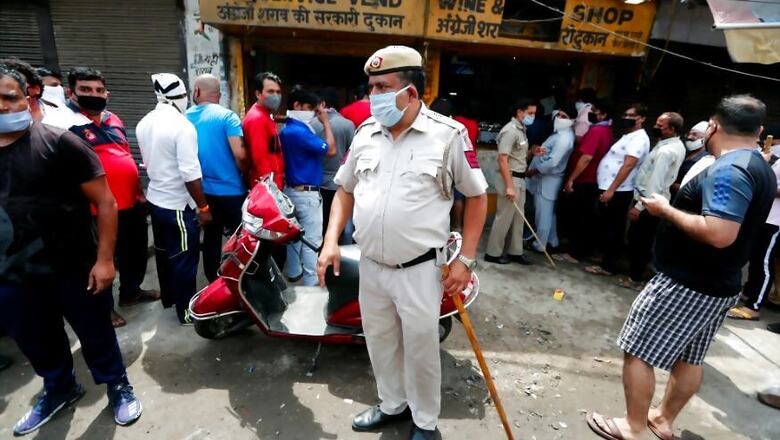
views
Delhi is witnessing a surge in Covid-19 cases at a time when India has moved into Unlock-1. Till June 8, the national capital had recorded 29,943 cases and 17,712 of them were active cases. In 874 people, the primary cause of death was the virus. Delhi’s Health Minister Satyendar Jain has said that cases are estimated to rise to 56,000 in the next two weeks. However, more importantly, Delhi’s Deputy Chief Minister Manish Sisodia said on Monday that the state disaster management authority will meet on Tuesday and the possibility of community transmission in the Capital will be examined. Sisodia said if community transmission is established, the strategies will have to change.
But what does community transmission mean and how is it established? What different strategies are adopted for it? News18 explains.
What are the different stages of coronavirus transmissions and how are they classified?
As per the World Health Organization (WHO), transmissions are characterised or classified as – sporadic cases, cluster of cases and community transmission. Earlier, it also used the local transmission classification. Sporadic cases refer to a small number of cases that are either imported or are detected locally. Local transmission indicates locations where the source of infection is within the reporting location.
A cluster of cases refers to cases that are clustered in time, geographic location and or by a common exposure. In India, clusters have been identified in Dharavi and Worli in Mumbai, Nizamuddin in Delhi, Bhilawara in Rajasthan and Koyambedu in Chennai.
The WHO refers to community transmission as larger outbreaks of local transmission that can be defined or identified through different approaches. It can be characterized by a situation where the original source of exposure cannot be found or cases that are detected through surveillance of a specific group of people. It can also be identified through multiple clusters in several areas.
What stage is India in right now?
The Ministry of Health and Family Welfare has steadfastly denied that India is community transmission stage of SARS-CoV-2 (Severe Acute Respiratory Syndrome Coronavirus -2) and said that the country is witnessing local transmission, clusters and large outbreaks in some places.
How does it get established that there is community transmission?
In simple terms, the inability to trace back the source of transmission in a well-defined geographical area can lead authorities to examine if there is community transmission. Till now, the Indian government has not made public any predefined protocol to establish community spread.
In each state, health departments have deployed frontline health workers for contact tracing of lab-confirmed positive cases. If contact tracing in multiple cases is unable to trace back the source, it is a strong indication of community transmission. The Integrated Disease Surveillance Programme (IDSP) in each state maintains a line-list of people who have had contact with lab-confirmed Covid-19 positive cases and this data is also shared with the National Centre for Disease Control.
The Integrated Disease Surveillance Programme (IDSP) can get a clear indication of community transmission in specific geographic locations based on the contact tracing and case load data. Besides, state governments have used epidemiological surveillance.
State governments such as Kerala have used epidemiological surveillance and sentinel surveillance to rule out prevalence of community spread. As News18 had reported in April, Kerala began this exercise late in April and collected samples from a carefully chosen cross-section of the society to see if there were clear signs of hints of community transmission. In May end, The Hindu reported that state’s department found only four Covid-19 positive cases at the end of the survey and none of the contacts of those four people tested positive. The state, thus, said the survey did not find any community transmission. However, the state government is going to have another round of survey, according to news reports.
Has the Indian government tried to check if there is community transmission?
Yes. The Indian Council of Medical Research (ICMR) had carried out sentinel surveillance among patients of Severe Acute Respiratory Illness (SARI) in the month of March to ostensibly find out prevalence of the Covid-19 outbreak, and for possible community transmission. Of the 5,911 people with severe acute respiratory illness (SARI) who were tested by the ICMR, 104 tested positive and 40 did not have any history of foreign travel or contact with a coronavirus-positive case. Even as the results of the survey hinted at community transmission as no source could be found for 40 patients, the Union Health Ministry flatly denied any community transmission.
The government also began a facility-based sero-survey last month across 67 districts to check for prevalence of Covid-19 infection in the country and to check for prevalence of antibodies. The survey aimed to look at low-risk and high-risk populations and asked states to collect 800 samples per month. Preliminary findings have revealed that in some districts facing high-case load, the infection has spread to 30 per cent of the population.
Does India have a broad strategy outlining management of different strategies?
India has a containment plan for large outbreaks that outlines the actions to be taken in case there is a large outbreak of the infection. However, this plan does not specify strategies to tackle community transmission.
A senior health department official of the Delhi government said, “We will have to scale up the containment plan outlined for large outbreaks if community transmission is established.”
As per the containment plan, a geographic quarantine strategy and cluster containment strategy have to kick-in. This means strict restrictions on movement in a well-demarcated geographical area, house-to-house detection, quick quarantine, isolation and enhancement of surveillance through proactive testing.




















Comments
0 comment